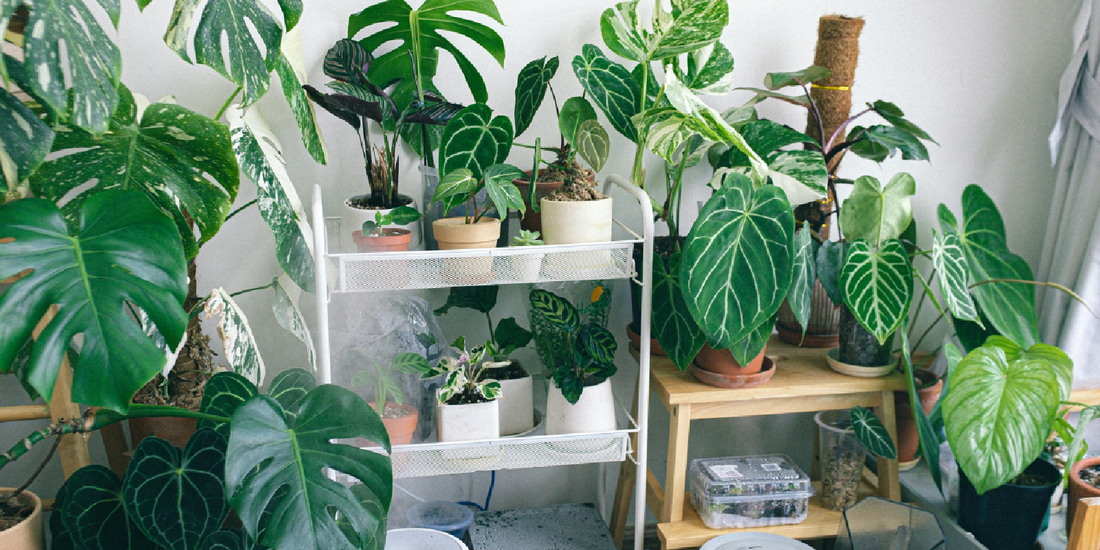
How to Rotate Plants on a Grow Light Shelf
Share
Introduction: Why Rotation Matters for Indoor Gardening
For indoor gardeners, one of the most overlooked but critical practices is rotating plants on a grow light shelf. While grow lights—like those integrated into the amoyls VerdantGlow S-Shaped 8-Tier Plant Shelf with Grow Lights—provide consistent illumination, plants can still develop uneven growth if left in the same position for weeks. The simple act of rotation ensures balanced exposure, healthier foliage, and stronger stems. Think of it as giving your plants a “turn in the spotlight.” Without it, you risk leggy stems, lopsided growth, and even overcrowding that affects airflow and plant health.
In this blog, we’ll explore why plant rotation is important, how often to do it, and step-by-step strategies for managing a multi-tier grow light shelf effectively.
The Science Behind Plant Rotation
Phototropism and Light Direction
Plants exhibit phototropism—the tendency to grow towards a light source. Even under grow lights that mimic the sun’s full spectrum, the angle of exposure affects how a plant develops. If a plant sits closer to the front of a shelf, its leaves may lean outward toward that stronger light angle, creating an uneven canopy.
Preventing Legginess
Without rotation, plants can become leggy—stretching too far in one direction. This doesn’t just look unhealthy; it weakens stems and reduces a plant’s ability to support flowers or fruit. Regularly rotating your plants helps maintain compact, symmetrical growth.
Air Circulation and Disease Prevention
Rotation isn’t just about light. Moving plants occasionally ensures that no single area of foliage is constantly crowded against another pot. Better airflow reduces risks of mildew, fungus, and pests.
How Often Should You Rotate Plants?
There’s no one-size-fits-all schedule, but general guidelines apply:
- Fast-growing seedlings (herbs, leafy greens): Rotate every 2–3 days.
- Moderate growers (ferns, small houseplants): Rotate once a week.
- Larger or established plants (succulents, tropicals, fruiting plants): Rotate every 2 weeks.
A good rule: every time you water, rotate. This keeps the habit consistent without requiring extra reminders.
Step-by-Step: Rotating Plants on an amoyls Grow Light Shelf
The amoyls VerdantGlow S-Shaped 8-Tier Plant Shelf with Grow Lights is designed for indoor gardeners who want both aesthetic design and functional grow light technology. Its multi-tier, space-saving structure means plants at different heights get different levels of light intensity. Here’s how to manage rotation effectively:
1. Assess Light Intensity Per Tier
- The top tier receives the strongest light.
- The middle tiers are optimal for medium-light plants.
- The lower tiers are slightly shaded, ideal for ferns or shade-tolerant varieties.
Understanding this helps you decide how to move plants vertically in addition to rotating them horizontally.
2. Establish a Rotation Direction
Choose either clockwise or counterclockwise, and stick to it. Consistency prevents you from losing track and helps plants get equal directional exposure.
3. Use Markers or Tags
Place a small sticker on the pot rim to remind yourself of the plant’s original orientation. Each time you rotate, turn it 90° so all sides eventually face the light.
4. Rotate Between Tiers
Every month, consider switching plants between higher and lower tiers. This mimics natural light changes and ensures all plants benefit equally.
5. Watch for Stress Signals
If a plant shows signs of stress—such as yellowing leaves or excessive stretching—adjust its tier or rotation frequency. Not all plants respond the same way.
Common Mistakes to Avoid
- Over-rotating: Moving plants daily can stress them. Allow them time to adjust before another shift.
- Ignoring plant type: Shade-loving plants (e.g., snake plants) may suffer if moved to the brightest tier.
- Crowding pots: Even with rotation, overcrowding blocks airflow. Keep enough spacing between pots.
- Forgetting vertical growth habits: Vines and tall plants need more frequent repositioning to prevent tangling.
Advanced Rotation Tips for Serious Gardeners
Pair Rotation with Pruning
After rotating, take a few minutes to prune back overgrown leaves. This balances growth and prevents shading smaller plants on lower tiers.
Track Growth Progress
Use your phone to snap monthly photos after each rotation cycle. Comparing these images shows you how effective your strategy is.
Use Timed Grow Lights
Since the amoyls VerdantGlow Shelf includes integrated grow lights, connect them to a timer. A cycle of 12–14 hours on, 10–12 hours off encourages natural rest and growth phases, reducing the need for constant manual adjustments.
Rotate by Plant Families
Group similar plants together on a tier and rotate groups, not individual pots. This reduces handling stress and simplifies the process.
The Role of Rotation in Aesthetic Plant Styling
Beyond growth, rotation plays a role in home aesthetics. The amoyls VerdantGlow S-Shaped design is as much décor as it is functional gardening equipment. Rotating ensures every leaf and bloom looks vibrant from all viewing angles, maintaining the stylish look of your indoor display.
For example:
- Ornamental foliage plants like calatheas look fuller when rotated regularly.
- Flowering plants like African violets showcase blooms more evenly.
- Trailing plants like pothos cascade beautifully when given balanced exposure.
Case Study: A Month of Rotation Results
One indoor gardener placed:
- Herbs (basil, parsley) on the second tier.
- Ferns on the lower tier.
- A peace lily on the middle tier.
After four weeks of consistent weekly rotation:
- Basil stems grew straight and compact.
- Fern fronds spread evenly instead of leaning.
- The peace lily produced symmetrical foliage without favoring one side.
This demonstrates how small adjustments lead to noticeable results.
FAQs About Rotating Plants on a Grow Light Shelf
Q: Do succulents need rotation under grow lights?
A: Yes. While succulents thrive in bright light, rotation prevents one side from stretching unnaturally.
Q: Should I rotate seedlings?
A: Absolutely. Seedlings are most prone to legginess and benefit greatly from frequent rotation.
Q: What if I can’t rotate regularly?
A: If time is limited, try adjusting plant placement monthly between tiers. Even occasional movement helps.
Conclusion: Small Action, Big Impact
Rotating plants on a grow light shelf may seem minor, but it dramatically improves plant health, structure, and aesthetics. With the amoyls VerdantGlow S-Shaped 8-Tier Plant Shelf with Grow Lights, rotation becomes easier thanks to its accessible design and well-balanced lighting system. Whether you’re growing herbs for the kitchen, nurturing tropicals, or decorating with foliage, consistent rotation ensures every plant gets its fair share of light.
By committing to this simple practice, you’ll enjoy a healthier, more vibrant indoor garden that truly thrives in both function and style.
